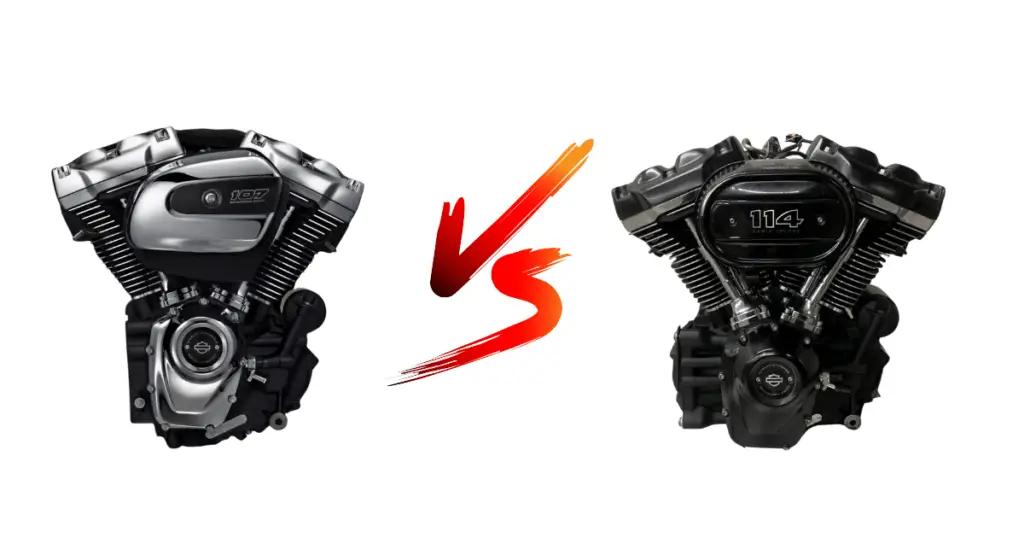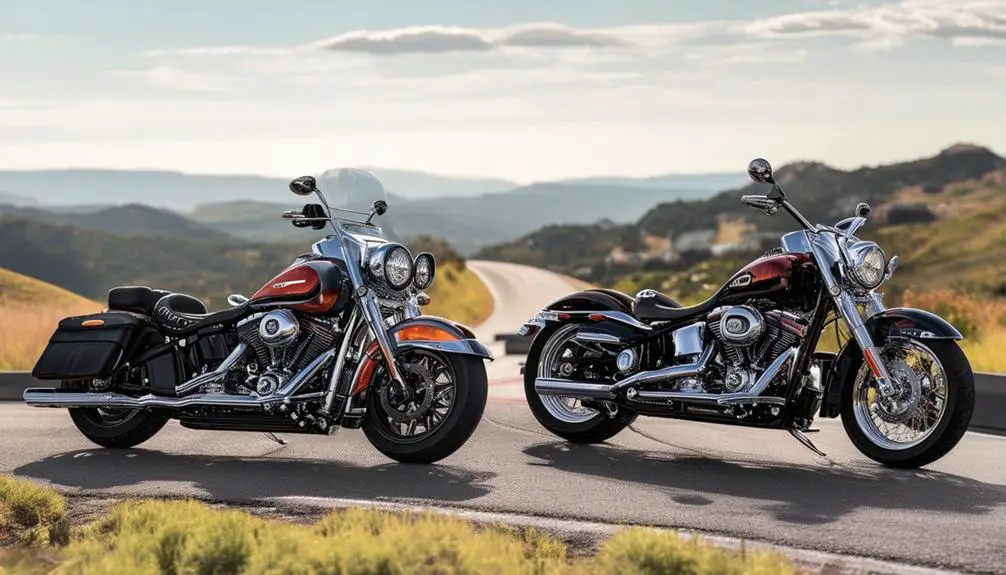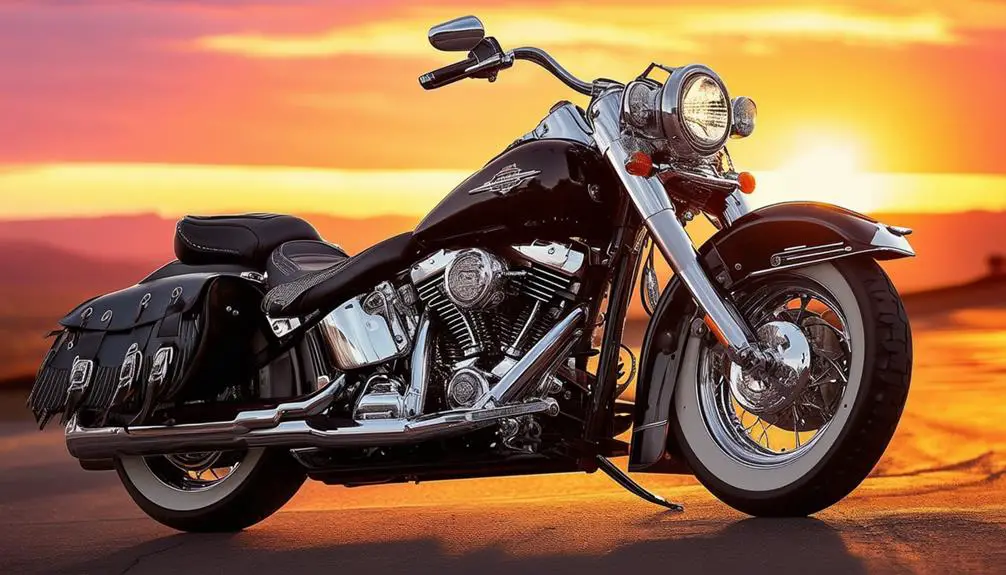If you’re a Harley enthusiast or planning to become one, choosing the right engine for your ride is a decision that commands attention. You may find yourself weighing the merits of the Milwaukee-Eight 107 against its heftier sibling, the 114. Each engine boasts distinct characteristics that cater to different riders’ preferences and the kind of performance they seek from their Harley-Davidson motorcycle. So which one would be right for you?
The Milwaukee-Eight 107 engine provides a smooth and reliable performance suitable for daily riding. It’s designed with oil-cooled cylinder heads and offers a balance of efficiency and power that’s both pleasing and practical for those who crave the Harley experience without needing excessive grunt. On the flip side, the 114 engine, which sports twin-cooled cylinder heads and punches in at a higher displacement, delivers increased power and torque, giving you that extra thrust for a more spirited ride.
Understanding the nuances between these two powerhouses will enhance your knowledge and help you make an informed decision that aligns with your riding style and needs. Whether it’s the touring capability, city cruising, or long stretches of open road that excites you, the choice between the Harley 107 and 114 engines is pivotal to your ultimate riding satisfaction. But what else do you need to know to make a decision? Let’s keep moving and see if we can find out!
The Harley 107 vs 114 Comparison: Straight from Milwaukee

In this section, you’ll discover the distinct characteristics and capabilities of the Milwaukee-Eight 107 and 114 engines that define their performance on the road.
Milwaukee Eight 107 Overview
The Milwaukee-Eight 107 engine is designed to provide you with a solid balance of power and efficiency. Here are some specifics:
- Displacement: 107 cubic inches (1,746 cc)
- Torque: Approximately 111 ft-lb at 3,250 RPM
This engine is known for its oil-cooled cylinder heads, which contribute to a consistent and reliable performance ideal for long rides and everyday commuting.
Related read: Is the Harley 107 a Good Engine? Maybe (and Here’s Why)
Milwaukee Eight 114 Overview
On the other hand, the Milwaukee-Eight 114 steps up the game with more robust features:
- Displacement: 114 cubic inches (1,868 cc)
- Torque: Peaks at around 119 ft-lb
With twin-cooled cylinder heads, the Milwaukee-Eight 114 engine offers a higher displacement and compression ratio than the 107, which translates to increased power output and torque, giving you that extra surge for a more exhilarating ride.
Related read: Is the Harley 114 a Good Engine? Yes, No, Maybe So (and Why)
Performance Aspects
When comparing the Harley 107 and 114 engines, you’ll find distinctions in power, fuel economy, and cooling systems that directly influence your riding experience. Let’s break down these performance aspects.
Power and Torque
The Milwaukee-Eight 107 and 114 engines both serve up that iconic Harley thrust, but the 114 has a slight edge. With its larger displacement, the 114 pulls stronger, delivering more torque and power. That means you’ll feel more force when you twist the throttle, especially at lower RPMs.
- 107 Engine: Adequate for casual and long-distance riders.
- 114 Engine: Preferred by those desiring extra punch during acceleration.
Efficiency and Fuel Economy
Talking about fuel efficiency is important because it’s about how far you can stretch each gallon of gas, and that affects your wallet. The 107 has a good balance of performance and fuel economy, but due to its larger size, the 114 is slightly less fuel-efficient. However, both engines are designed to meet EPA guidelines, ensuring you get the most out of your fuel.
- 107 Engine: Better mpg under similar conditions.
- 114 Engine: Lower mpg but offers higher performance.
Heat Management and Cooling System
Heat is the enemy of performance; the smoother your engine runs, the better your ride. The 107 boasts streamlined heat management thanks to oil-cooled heads, meaning less stress on your engine during those long rides. Meanwhile, the 114 employs a twin-cooled system involving both oil and coolant, resulting in improved heat dissipation.
- 107 Engine: Oil-cooled heads for consistent cooling.
- 114 Engine: Twin-cooled system to handle additional heat from the increased power.
Both engines have made strides in minimizing vibration for a more comfortable ride and ensuring optimal performance in the long haul. Regular maintenance of the cooling system can significantly enhance fuel efficiency and engine life.
Related read: Total Harley 114 vs 117 Comparison – Which Reigns Supreme?
Engine Specifications and Design
When you’re comparing the Harley 107 and 114 engines, it’s crucial to look at their technical specs and design features. These aspects play a significant role in how these engines perform and feel on the road.
Technical Specs and Comparison
Harley-Davidson Milwaukee-Eight 107:
- Displacement: 1,746cc
- Bore x Stroke: 3.937 in. x 4.375 in.
- Compression Ratio: 10.0:1
- Max Torque: 111.2 ft-lb at 3,250 rpm
Harley-Davidson Milwaukee-Eight 114:
- Displacement: 1,868cc
- Bore x Stroke: 4.016 in. x 4.5 in.
- Compression Ratio: 10.5:1
- Max Torque: 119 ft-lb at 3,250 rpm
| Specification | 107 | 114 |
|---|---|---|
| Displacement | 1,746cc | 1,868cc |
| Bore x Stroke | 3.937 x 4.375 in. | 4.016 x 4.5 in. |
| Compression Ratio | 10.0:1 | 10.5:1 |
| Max Torque | 111.2 ft-lb at 3,250 rpm | 119 ft-lb at 3,250 rpm |
The 114 engine offers a higher displacement and compression ratio, leading to better performance and increased torque. Both engines feature a counter-balancer to reduce primary vibration, enhancing your riding experience by making it smoother.
Physical Design and Engine Aesthetics
Along with performance specs, the physical design and aesthetics of an engine are paramount to maintaining the iconic Harley-Davidson look while improving functionality. Both the 107 and 114 engines feature a refined V-Twin design, crucial for airflow efficiency and reduced vibration.
The engines are designed with an emphasis on airflow, with a 50% increase in intake and exhaust flow capacity compared to previous models. This means that not only do these engines look great with their classic V-Twin structure, but they also function at an optimal level with a cool-running performance.
Remember, it’s not just about how much power the engine has, but also how it integrates with the rest of the bike to provide you with a cohesive riding experience. The aesthetic design, paired with a focus on reduced vibration, ensures that you not only have an engine that performs well but also feels great as you ride.
Related read: Harley’s Milwaukee 8 Review: Specs, Problems, and More
Riding Experience
When comparing the Harley 107 and 114 engines, your experience on the road will hinge on how these engines enhance ride quality through customization options, auditory feedback, and bike handling.
Customization and Riding Style
The Harley 107 and 114 engines both offer ample opportunity for customization to suit your riding style. With the 107, you have a solid foundation for everyday reliability, and it’s adaptable enough for performance upgrades. The 114 engine, in contrast, starts with a higher baseline of power, providing the throttle response and punch you need for a more spirited ride. Here’s how you might customize each:
- Harley 107: Add a performance exhaust; upgrade cams for a smoother power curve. Tuner options also available.
- Harley 114: Opt for a high-flow air cleaner; consider a tuner to maximize engine performance.
Sound and Sensation
The iconic Harley rumble is a key part of the sensory experience of riding, and both engines have a distinct sound profile. The 107 might be described as steady and reassuring, whereas the 114 offers a deeper, more pronounced growl that hints at its increased power. Adjustments such as exhaust system updates can further refine these characteristics. Remember, the sound is more than an auditory pleasure—it’s feedback about your bike’s performance.
Balance and Handling
Your confidence and comfort on the road depend largely on the balance and handling of your ride. Both engines are nested within bikes designed for stability, but the extra power of the 114 can affect handling. It’s your preference:
- Harley 107: Known for smooth acceleration and ease of handling, making it reliable for both city cruising and long rides.
- Harley 114: Provides a more aggressive riding experience, with increased torque that demands a bit more skill to harness effectively.
Technical Innovations Over Previous Engines
When it comes to upgrading your Harley, the Milwaukee-Eight series engines offer a host of technical innovations that can enhance your ride, particularly in performance and cooling efficiency.
Upgrades for Performance Tuning
Upgrading your Harley with performance tuning elements can markedly improve power delivery. For example, a tuner for the Milwaukee 8 114 engine like the Dynojet Power Vision can optimize the air/fuel ratio and ignition timing to unleash additional power. This device is user-friendly, with features like Bluetooth connectivity for easy adjustments:
- Bluetooth Connectivity: Modify settings wirelessly.
- Dynojet Power Vision: A comprehensive tool for customizing performance parameters.
Installing a tuner not only allows for fine-tuning but also works in harmony with other performance upgrades you may consider, like high-flow air filters or aftermarket exhaust systems, for that extra thrust of power.
Advancements in Heat Dissipation
Harley’s Milwaukee-Eight engines, especially the 114, boast advanced cooling systems that play a pivotal role in maintaining optimum performance. Here’s a glance at the features:
- Liquid-Cooled Cylinder Heads: Found on the 114, these aid significantly in temperature control.
- Four-Valve Cylinder Heads: Increase airflow, leading to enhanced performance and cooler running.
- Enhanced Cooling System: Ensures the engine operates within the ideal temperature range, preventing overheating.
Your engine’s ability to disperse heat not only contributes to consistent performance but also extends the lifespan of the engine components. Whether you’re stuck in traffic or cruising on the highway, these innovations keep your engine’s temperature in check, ensuring a smooth and reliable ride.
Longevity and Maintenance Reports
When considering the Harley-Davidson Milwaukee-Eight 107 and 114 engines, you want them to last. Understanding the typical issues they might encounter and the maintenance practices necessary can ensure longevity.
Reliability and Common Issues
The Milwaukee-Eight 107 and 114 engines are known for their reliability, largely due to Harley-Davidson’s strong engineering background. However, like any engine, they have their common issues. One notable concern is with the oil pump, where some riders have reported inefficiency over time. This can lead to oil pressure problems that might affect the engine’s longevity if not addressed.
- Common Concerns:
- Oil pump inefficiencies
- Minor oil leaks
Maintaining a close eye on these can help you catch and address problems early.
Maintenance and Upkeep
Regular maintenance is the key to ensuring your Harley’s engine remains in top condition. You should routinely check and replace the oil to keep your engine’s internal components well-lubricated and cool, which is especially important for air and twin-cooled engines like the 107 and 114.
- Maintenance Checklist:
- Check oil levels and quality regularly
- Replace the oil and oil filters as recommended
- Inspect gaskets for any sign of wear or leaks
Sticking to a regular maintenance schedule will help spot any red flags before they escalate into more serious issues. Remember, a well-maintained engine is a reliable engine.
Purchasing Insights Between The 107 and 114 Engines
When you’re considering the purchase of either a Harley 107 or a Harley 114, it’s crucial to weigh the cost against the benefits, understand how each engine fares for long trips, and acknowledge what ownership of these popular engines entails.
Cost-Benefit Analysis
When deciding between Harley 107 and Harley 114, the initial pricing can be deceptive. The 107 might seem more cost-effective upfront, but the long-term value of the 114’s higher displacement could offer you more bang for your buck. Here’s a quick comparison:
- Harley 107: Cheaper, but less power
- Harley 114: More expensive, but higher power and potentially better for resale value
It’s essential to consider your budget and how much the added horsepower matters to you.
Suitability for Long Trips
For those of you who dream of long trips on the open road, the engine you choose can significantly impact your experience. The Harley 114, with its higher displacement, tends to present a smoother ride with extra power for highway cruising. In contrast, the Harley 107 might be more suitable for daily commutes or shorter rides. Remember, your comfort and the bike’s performance over long distances should inform your choice.
Frequently Asked Questions
In this section, you’ll find direct answers to common inquiries regarding the differences and specifics of Harley 107 and 114 engines.
What are the main differences between a Harley 107 and 114 engine?
The key difference lies in their displacement; the Harley 107 has 107 cubic inches, while the 114 boasts a larger 114 cubic inches. This affects the power and torque, with the 114 having higher outputs.
Can you upgrade a Harley 107 to a 114, and if so, how?
Yes, you can upgrade a Harley 107 to a 114 engine. Upgrades involve a larger bore kit and may require additional changes such as enhanced camshafts, fuel systems, and mapping for optimal performance.
What is the impact on performance when comparing the 107 and 114 engines?
As you step up from the 107 to the 114, expect a noticeable enhancement in acceleration and overtaking capabilities due to the increase in torque and horsepower with the 114 engine.
Are there any notable differences in maintenance requirements between the 107 and 114?
Maintenance requirements between the two engines are generally similar, but the 114 may necessitate more frequent attention due to its higher performance nature.
How does the engine choice between a 107 and 114 affect resale value?
Motorcycles equipped with the 114 engine typically hold their value better because of the higher demand for the increased performance that the 114 provides.
What are the fuel efficiency comparisons like between the Harley 107 and 114 engines?
While both engines are not vastly different in fuel efficiency, the 107 may have a slight edge due to its smaller displacement and lower power output. However, riding styles and conditions greatly affect actual efficiency.








Leave a Reply
You must be logged in to post a comment.